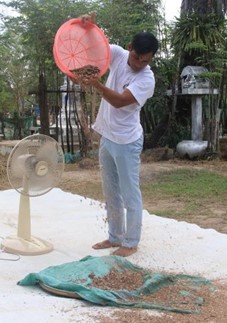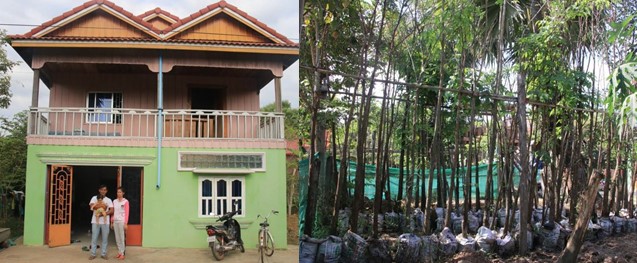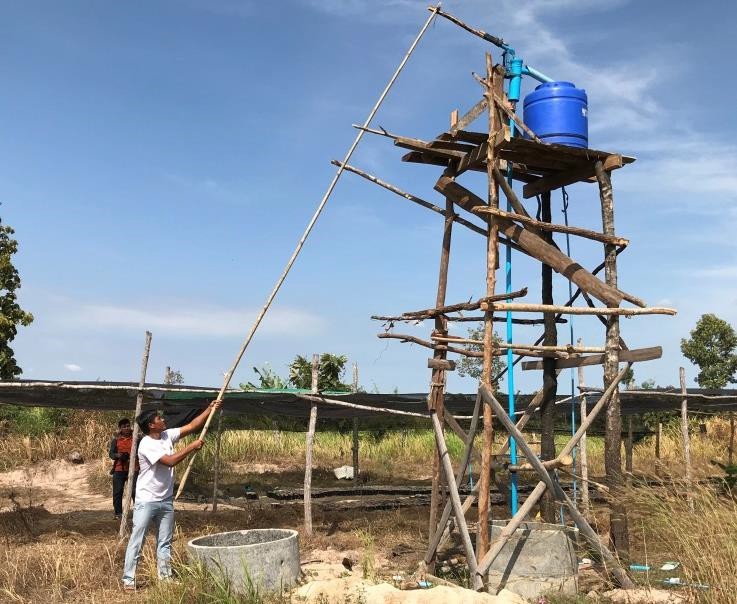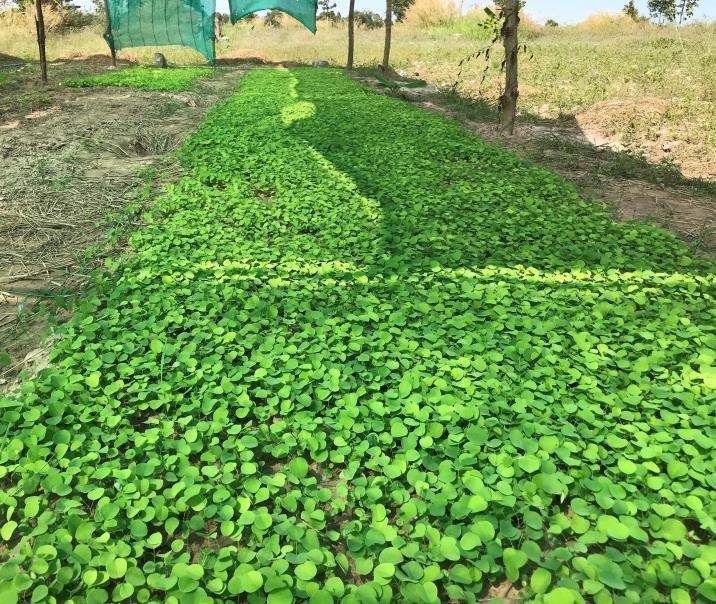A Story of AFoCO/003/2014 ‘Promotion of Forest Rehabilitation in Cambodia and Viet Nam Through Demonstration Models and Improvement of Seed Supply System’

Large quantities of tree seeds are used every year in Cambodia’s reforestation program. In 2015 about 15,000 kg of tree seeds were procured by nurseries across the country. It is expected that the amount of seed needed will increase in the coming years. More than 40 tree species are widely used in tree planting. Those of the luxury group, such as Dalbergia cochinchinensis, D. oliveri, Pterocarpus macrocarpus and Afzelia xylocarpa, are in high demand. For example, in 2015, about
1.2 million seedlings of D. cochinchinensis were produced in the whole country. Where do tree seeds come from? Who are the seed suppliers?
The seed collectors
Along Road 155 connecting the provincial town to Phnom Kravanh district town, at kilometer post 20 in O Srao Village, Progneul commune, Kravanh district, stands the house of Mr Suth Sok Em. He is 32 years old, and is the second child in a farmer’s family of five children. He started making a living as a seed collector and seller in 2011 after receiving training on seedling production from the Institute of Forest and Wildlife Research and Development in that year. He is a member of O Srao Community Forestry.

The seed sources
Phnom Kravanh district is rich in natural resources such as mountains, rivers, forests and wildlife. These resources contribute to rural economic development and local communities actively participate in forest management. There are 14 community forests dotted around the district, covering a total area of about 3,000 ha. Although community forest management faces some challenges, the forests have been protected. Some natural forest stands in Progneul commune are considered seed sources for several high-value timber species, including Dalbergia cochinchinensis, Pterocarpus macrocarpus and Xylia xylocarpa. This source constitutes a network of 15 seed sources across the whole country.
On privately owned land adjacent to Kampeng and O Srao community forests, there are some good stands of mature D. cochinchinensis and Pterocarpus macrocarpus where seeds can be collected. Mr Sok Em normally pays 50,000 riels (US$12.5) to the landholder for each fruiting tree of D. cochinchinensis before he collects seed. He does not need to pay for other species, such as Dipterocarpus alatus and Anisoptera costata, which are still commonly available in the area, but he must obtain the landholder’s permission before he collects seed. In 2018, he collected and sold 1,300 kg of seeds of seven species. The price of seeds varies significantly between species. For example, a kilogram of processed D. cochinchinensis seed sells for US$150 whereas a kilogram of Dipterocarpus alatus fetches only US$1.25 (price at his house). The traders who but D. cochinchinensis seed from him demand US$200–250 per kg from nursery managers. The price of D. cochinchinensis seed is even higher in years when there are few or even no seeds to collect. It is worth noting that hard-coated (orthodox) seeds, such as D. cochinchinensis and Afzelia xylocarpa, can be stored in ordinary room conditions for three to five years with minimal loss of viability. By contrast, recalcitrant seeds, such as D. alatus and A. costata, can be stored for seven days only.
“Before I received the seed collecting equipment, it would take me two days on average to harvest seed from just one tree. But now that I have the proper equipment, it takes half a day only”
Mr Suth Sok Em speaking of the advantage of the specialized equipment he received from the project last year

(Photo) Mr Suth Sok Em climbing a tree (Pterocarpus macrocarpus) using a ladder, safety harness and long-handled pruning saw (not visible in the photo) (left) and a stand of Dalbergia cochinchinensis on private land near O Srao Community Forest (right)
Mr. Suth Sok Em is one of 12 seed suppliers from across the country who last year received seed harvesting equipment from the AFoCO-funded regional project “Promotion of Forest Rehabilitation in Cambodia and Vietnam through Demonstration Models and Improvement of the Seed Supply System.” The equipment includes an extendable ladder, safety harness, hard hat, long- and short-handled pruning saws, and some bags. Having this equipment significantly reduces the time spent collecting seeds and ensures the collector’s safety while climbing trees. Because Mr. Suth Sok Em is a trained seed collector, he knows how to select good seeds, and therefore the seed he supplies usually has high germination rates.
Mr. Sok Em started producing seedlings of D. cochinchinensis at home after he completed high school. As the business grew, he was able to buy a 2 ha plot of land, which he acquired a year ago and is about 3 km from his home, to establish a small nursery. The nursery is basic with a shaded area, a small pond and watering system. He mainly produces seedlings of three species – Dalbergia cochinchinensis, D. oliveri and Pterocarpus macrocarpus – as these are in high demand across the country. This year he secured a contract to supply 20,000 seedlings of D. cochinchinensis to the Department of Tree Planting of the Forestry Administration. He advertises his business on Facebook under his name: Suth Sok Em; and has built good relationships with large-scale tree nurseries all around the country.
“In the dry (the fruiting) season I collect seeds and in the wet season I produce seedlings”
Mr. Sok Em
The benefits of a farmer-managed seed and seedling supply system
The income Mr Sok Em earns from selling seeds and seedlings is the main source of livelihood for his family. With the money he has saved since 2011, he has built a new house and bought two motorcycles. In 2018, he bought the 2 ha of farmland at a cost of US$6,000 to set up a tree nursery. The savings from this business paid for his wedding ceremony in 2016. He is currently providing financial support for his younger sister to study at IMD Institute in Pursat town for four years. The seed and seedling business provides seasonal job opportunities for local communities in this area. Mr Sok Em employs up to 10 villagers to collect seeds, tend to seedlings in the nursery, and sell seeds and saplings.

Challenges
The business of collecting tree seed and growing saplings faces some challenges. In general, trees do not produce (or mass produce) fruits every year. In Mr Sok Em’s area, mass fruiting of Dalbergia cochinchinensis occurs every second or third year. Rains and storms in the pre-ripening period can cause significant damage to seeds or blow fruits off the trees before they are fully ripe. Winged seeds like those of D. cochinchinensis are easily blown a few hundred meters from the trees. On the other hand, in the past 10 years D. cochinchinensis has been promoted in tree planting programs, and some of the trees are already producing seeds. Seed sales are therefore expected to decline because some nursery managers may opt to collect seeds from the planted trees even though they are not a proper seed source. Apart from Mr Sok Em, there are two main suppliers of
D. cochinchinensis, one in Siem Reap province and the other in Kampong Speu province. However, there is no competition between these suppliers because there is a good balance between supply and demand for this species.
What to do in the future?
Mr Sok Em is committed to supplying seeds and seedlings for the foreseeable future. He has two priorities for improving his business. The first is to upgrade the existing nursery. This task includes laying a concrete base, building a storage shed and installing a water pump to modernize the watering system. Second, he will establish small seed sources of D. cochinchinensis and
P. macrocarpus on his farmland, probably about 100 trees of each species, so that he will not need to rely on buying seeds from other community members in the future. Note that for establishing a good seed source, seeds must be equally collected from 25–30 mother trees. When asked why he had chosen not to plant D. oliveri as a seed source, he said that “the species grows much slower than D. cochinchinensis and P. macrocarpus.” This is correct because D. oliveri is site selective; it grows best on fertile soils, so its natural habitats are not as widely distributed as the other two. However, because the species is indigenous to this area, it may not be difficult to plant it for a seed source.




